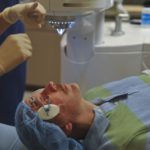
Diabetic Eye Treatment
Diabetes affects the eyes gradually and can greatly affect vision
Diabetes affects your eyes when your blood glucose, also called blood sugar, is too high.
The duration of diabetes is the strongest predictor for development and progression of diabetic retinopathy. If blood glucose stays high over time, it can damage the tiny blood vessels in the back of your eyes. This damage can begin pre diabetes, when blood glucose is higher than normal, but not high enough for you to be diagnosed with diabetes. Damaged blood vessels may leak fluid and cause swelling. New, weak blood vessels may also begin to grow. These blood vessels can bleed into the middle part of the eye, lead to scarring, or cause dangerously high pressure inside your eye. Over time, diabetes can cause damage to your eyes that can lead to poor vision or even blindness.
Diabetic eye disease can be prevented with regular checking
You can take steps to prevent diabetic eye disease, or keep it from getting worse, by taking care of your diabetes. Often, there are no warning signs of diabetic eye disease or vision loss when damage first develops. A full, dilated eye exam helps your doctor find and treat eye problems early—often before much vision loss can occur. At Poona Eye care, we offer the complete range of diabetic eye care services from diagnostics to surgery.
Drag ![]() left/right for full view
left/right for full view


| Normal Vision | Affected Vision |
Frequently Asked Questions
What are the different eye problems connected to diabetes?
Most serious diabetic eye diseases begin with blood vessel problems.These conditions include diabetic retinopathy, diabetic macular edema, cataracts and glaucoma.
Diabetic retinopathy
The most common problem with the greatest potential to cause blindness is diabetic retinopathy. The retina is the inner lining at the back of each eye. The retina senses light and turns it into signals that your brain decodes, so you can see the world around you. Damaged blood vessels in the eye can harm the retina, causing a disease called diabetic retinopathy.
In early diabetic retinopathy, blood vessels can weaken, bulge, or leak into the retina. This stage is called non-proliferative diabetic retinopathy.
If the disease gets worse, some blood vessels close off, which causes new blood vessels to grow, or proliferate, on the surface of the retina. This stage is called proliferative diabetic retinopathy. These abnormal new blood vessels can lead to serious vision problems.
Macular edema
Macular edema is the build-up of fluid in the macula, an area in the center of the retina. Fluid buildup due to diabetic retinopathy causes the macula to swell and thicken, which distorts vision. Macular edema can also occur after eye surgery, in association with age-related macular degeneration, or as a consequence of inflammatory diseases that affect the eye. Any disease that damages blood vessels in the retina can cause macular edema.Over time, this disease can destroy sharp vision, thus leading to partial vision loss or blindness.
Diabetic macular edema (DME) is of two types – Focal DME and Diffuse DME. Focal DME occurs because of abnormal blood vessels. Diffuse DME occurs because of widening/swelling retinal capillaries (very thin blood vessels).
Glaucoma
Glaucoma is a group of eye diseases that can damage the optic nerve—the bundle of nerves that connects the eye to the brain. Diabetes doubles the chances of having glaucoma, which can lead to vision loss and blindness if not treated early.
Cataract
Cataract is a clouding of the lens of the eye that impairs vision. Cataract formation associated with diabetes often occurs because of excess levels of sorbitol (a sugar formed from glucose), which form deposits within the lens.
What is the treatment for diabetic eye problems?
Diabetic eye care includes better control of the disease, to avoid problems in the long run.
Medical treatment of diabetic eye disease is generally directed at the underlying problem – the diabetes itself. Monitoring the patient's glycosylated haemoglobin is the best assessment of the overall level of blood sugar control. A medical doctor will order this blood test at least once a year. If the patient's results are initially found to be abnormal or if the patient's self-test blood sugar results become more variable, then this blood test may be ordered more frequently.
- For diabetic retinopathy, available medical treatment includes injections of corticosteroids or anti-vascular-proliferative medications in the area around the eye. In some cases, vitreoretinal surgery may be necessary.
- The presence of glaucoma requires the use of antiglaucoma medications in the form of eye drops. Surgical options can be recommended in some cases.(Glaucoma Treatment)
- For cataract, the treatment is to replace the clouded lens with an artificial lens.(Cataract Treatment)
- The treatments for focal and diffuse DME differ, but they both involve laser procedures. Most doctors use focal laser treatment to treat focal DME and grid laser treatment to treat diffuse DME.
What is the treatment for proliferative diabetic retinopathy?
The first step in any treatment for diabetic eye disease is to maintain blood glucose, blood pressure, and blood cholesterol levels as close to normal as possible. Laser procedure and traditional surgery are often used in the treatment of diabetic eye disease.
Treatment methods:
Intraocular injection (Injecting medicine into the eye)
Your doctor may suggest injecting medication into the vitreous in the eye. These medications, called vascular endothelial growth factor (VEGF) inhibitors, may help stop growth of new blood vessels by blocking the effects of growth signals the body sends to generate new blood vessels.
Laser treatment
Photocoagulation –
This laser treatment, also known as focal laser treatment, can stop or slow the leakage of blood and fluid in the eye. During the procedure, leaks from abnormal blood vessels are treated with laser burns.
Panretinal photocoagulation –
This laser treatment, also known as scatter laser treatment, can shrink the abnormal blood vessels. During the procedure, the areas of the retina away from the macula are treated with scattered laser burns. The burns cause the abnormal new blood vessels to shrink and scar.
Vitrectomy –
This procedure uses a tiny incision in your eye to remove blood from the middle of the eye (vitreous) as well as scar tissue that's tugging on the retina. It's done using local or general anesthesia.
Even after treatment for diabetic retinopathy, regular eye checks are a must. At some point, additional treatment may also be recommended.
What is the treatment for diabetic macular edema?
Corticosteroid (steroid) treatments, which reduce inflammation, are the primary treatment for macular edema caused by inflammatory eye diseases.
Intravitreal injection is an important treatment method for macular edema. The drugs used in this treatment block the activity of a substance called vascular endothelial growth factor (VEGF). The anti-VEGF drugs block vessel formation and prevent leakage in the retina.
Some cases of macular edema are caused when the vitreous (the gel that fills the area between the lens and the retina) pulls on the macula. Surgery to remove the vitreous gel, called a vitrectomy, relieves the pulling on the macula. Vitrectomy also may be required to remove blood that has collected in the vitreous. Photocoagulation (focal laser treatment) and
anretinal photocoagulation (grid laser treatment) are the laser surgeries used to treat macular edema.
Normal recovery time after a DME procedure is 3-6 months. As the eye heals and the swelling in and around the macula subsides, you may experience sensitivity to light, irritation in the eye, and black spots in the center of your vision. These are normal side effects, and they will likely disappear with time.
At what stage should one consult a doctor?
You need to see a doctor if:
- Cannot see well in dim light.
- Have blind spots.
- Have double vision (you see 2 things when there is only 1).
- Vision is hazy or blurry and you cannot focus.
- Eye pain.
- Headaches.
- Spots floating in your eyes.
- Cannot see things on the side of your field of vision.
- See shadows.
What are the best ways to manage diabetes and keep eyes healthy?
Few tips to prevent diabetic eye problems:
- Manage blood glucose, blood pressure, and cholesterol
- Quit smoking.
- Get a dilated eye exam done once a year.
- Maintain a nutritional diet.
- Engage in regular exercise.
Other treatments at Poona Eye Care
Please do write to us if you have any more queries on this. We will be glad to assist.
CONTACT US

- Shop No. 1, Lajawanti Apartments, 62/9 Erandawane, Opposite Sonal Hall, Karve Road, Pune-411004, Maharashtra, India.
- +91 735-027-7779
- info@poonaeyecare.com
Working Hours
- MON: 9:00 AM - 08:00 PM
- TUES: 9:00 AM - 08:00 PM
- WED: 9:00 AM - 08:00 PM
- THUR: 9:00 AM - 08:00 PM
- FRI: 9:00 AM - 08:00 PM
- SAT: 9:00 AM - 01:00 PM



